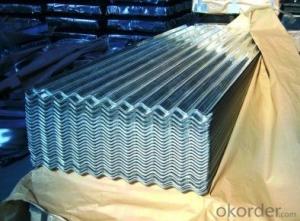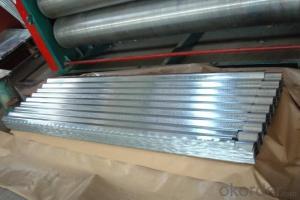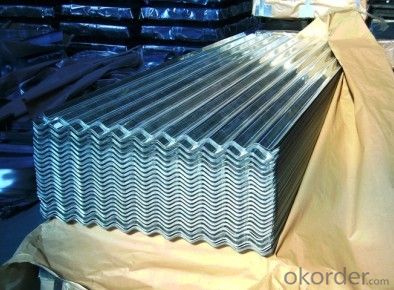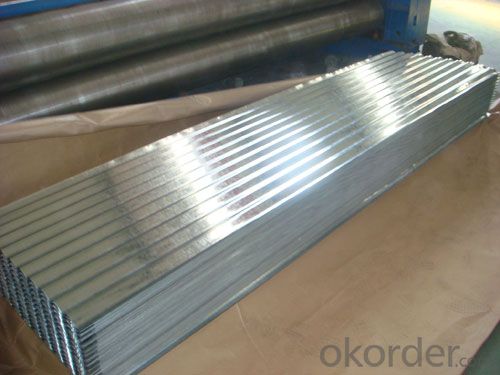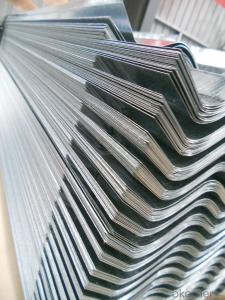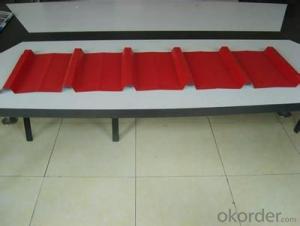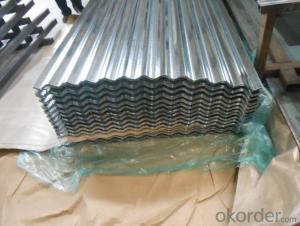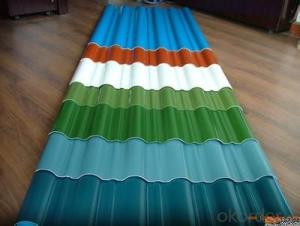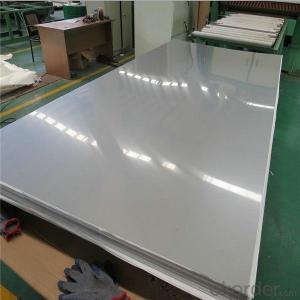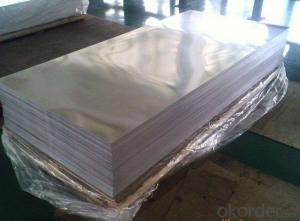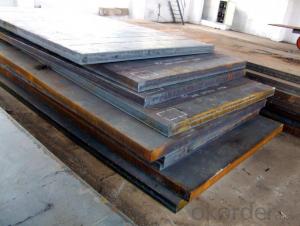GALVANIZED STEEL CORRUGATED SHEETS
- Loading Port:
- Tianjin
- Payment Terms:
- TT OR LC
- Min Order Qty:
- -
- Supply Capability:
- 10000 m.t./month
OKorder Service Pledge
OKorder Financial Service
You Might Also Like
GALVANIZED STEEL CORRUGATED SHEETS
THICKNESS:0.20mm
WIDTH:800mm(AFTER CORRUGATION)
LENGTH:1828mm
ZINC COATING:60g/m2
STANDARD:JIS G 3302, SGCH (HARD QUALITY:75HRB-90HRB)
SURFACE:REGULAR SPANGLE, CHROMATED, DRY
PACKAGE WEIGHT:ABOUT 3 TONS
PAYMENT TERM:30% TT advance,70% against BL copy OR 100% LC AT SIGHT.
SHIPMENT: WITHIN 35 DAYS AFTER RECEIVING THE DEPOSIT.
DOUCUMENTS:COMMERCIAL INVOICE IN THREE ORIGINAL,PACKING LIST IN ONE ORIGINAL AND SPECIFICATION,CERTIFICATE OF ORIGIN.
ORIGIN:MADE IN CHINA
LABEL INFORMATION:AS REQUEST.
PORT OF LOADING: XINGANG PORT, CHINA
- Q: What are the different types of surface patterns available for steel sheets?
- There are several different types of surface patterns available for steel sheets, including smooth, textured, embossed, diamond, and perforated patterns.
- Q: How are steel sheets inspected for defects?
- Steel sheets are inspected for defects using various techniques and methods to ensure their quality and reliability. One common method is visual inspection, where trained inspectors carefully examine the surface of the steel sheet for any visible defects such as cracks, scratches, dents, or surface irregularities. This is typically done under proper lighting conditions to enhance visibility. Another technique is magnetic particle inspection, which is used to detect surface or near-surface defects in ferromagnetic materials like steel. In this method, a magnetic field is applied to the steel sheet, and iron particles are then applied to the surface. If there are any defects, these particles will be attracted and form visible indications, allowing inspectors to identify the location and size of the defect. Ultrasonic inspection is another commonly used method that involves the use of high-frequency sound waves to detect internal defects in steel sheets. Ultrasonic waves are passed through the material, and any changes in the wave patterns caused by defects are detected by sensors. This non-destructive testing method can identify defects such as voids, cracks, or inclusions that may not be visible to the naked eye. Other techniques used for defect detection in steel sheets include eddy current testing, where electrical currents are induced in the material to detect surface defects, and X-ray inspection, which uses high-energy X-rays to reveal any internal flaws. Overall, a combination of visual inspection and non-destructive testing methods is employed to thoroughly inspect steel sheets for defects, ensuring that only high-quality sheets are used in various applications like construction, automotive, or manufacturing industries.
- Q: Can steel sheets be welded or joined together?
- Yes, steel sheets can be welded or joined together. Welding is a common method used to join steel sheets together. It involves melting the edges of the sheets and then allowing them to cool and solidify, creating a strong bond between the two sheets. Welding is an effective way to join steel sheets as it provides a durable and permanent connection that can withstand high levels of stress and load. Additionally, other methods such as riveting, bolting, and adhesive bonding can also be used to join steel sheets together depending on the specific application and requirements.
- Q: How are steel sheets protected during storage in outdoor environments?
- Steel sheets are protected during storage in outdoor environments through the application of various protective measures. These measures may include the use of weather-resistant coatings, such as galvanization or paint, to prevent corrosion and rusting. Additionally, steel sheets can be stored on pallets or racks to minimize contact with the ground and reduce the risk of moisture accumulation. Covering the sheets with tarpaulins or using weatherproof storage containers further shields them from direct exposure to rain, snow, and sunlight. Regular inspections and maintenance are crucial to ensure the effectiveness of these protective measures and to address any potential issues promptly.
- Q: What are the different coating options available for steel sheets?
- There are several coating options available for steel sheets, each offering unique benefits and protection against various environmental factors. Some of the most common coating options include: 1. Galvanized Coating: This is the most widely used coating for steel sheets. It involves applying a layer of zinc to the surface, which acts as a sacrificial anode and prevents corrosion. Galvanized coating provides excellent corrosion resistance and is suitable for both indoor and outdoor applications. 2. Galvannealed Coating: This coating is similar to galvanized coating but is further heat-treated to form a zinc-iron alloy layer on the surface. Galvannealed coating offers improved paint adhesion and weldability, making it suitable for applications that require painting or additional fabrication processes. 3. Electroplated Coating: This process involves immersing the steel sheet in a solution containing metal ions and applying an electric current to deposit a thin layer of metal onto the surface. Common electroplated coatings include zinc, nickel, and chromium. Electroplated coatings provide enhanced corrosion resistance and can also improve aesthetics. 4. Organic Coating: Also known as painted or coated steel sheets, this option involves applying a layer of organic material such as paint, powder coating, or plastic film to the steel surface. Organic coatings provide protection against corrosion, UV radiation, and abrasion. They also offer a wide range of colors and finishes, making them suitable for architectural and decorative applications. 5. Tin Coating: Tin-plated steel sheets have a thin layer of tin applied to the surface through an electroplating process. Tin coating provides excellent solderability, corrosion resistance, and food-grade suitability. It is commonly used in the production of food cans and other packaging materials. 6. Aluminized Coating: This coating involves applying a layer of aluminum to the steel surface through a hot-dipping process. Aluminized coating provides excellent heat reflectivity, corrosion resistance, and thermal conductivity. It is often used in applications that require heat resistance, such as exhaust systems and heat exchangers. These are just a few of the many coating options available for steel sheets. The choice of coating depends on factors such as the intended use, environmental conditions, and desired properties of the steel sheet. It is essential to consider these factors and consult with coating experts to determine the most suitable option for specific applications.
- Q: Are steel sheets suitable for industrial machinery components?
- Yes, steel sheets are suitable for industrial machinery components due to their high strength, durability, and ability to withstand heavy loads and extreme conditions commonly found in industrial settings. Steel sheets also offer excellent machinability, allowing for precise shaping and customization of components as per specific requirements. Additionally, steel sheets can be easily welded, offering flexibility in design and assembly processes.
- Q: What is the thickness tolerance for steel sheets?
- The thickness tolerance for steel sheets typically depends on the specific grade and manufacturing process, but it generally ranges from +/- 0.005 to 0.015 inches.
- Q: What are the different types of surface finishes available for steel sheets?
- Some different types of surface finishes available for steel sheets include hot rolled, cold rolled, galvanized, and coated finishes.
- Q: Can steel sheets be used for safety barriers or guardrails?
- Yes, steel sheets can be used for safety barriers or guardrails. Steel sheets are commonly used in construction and infrastructure projects due to their strength and durability. They are often used to create robust safety barriers and guardrails that provide protection and prevent accidents in various settings such as highways, bridges, and industrial facilities.
- Q: Can steel sheets be used for staircases?
- Yes, steel sheets can be used for staircases. Steel sheets are often used in the construction of staircases due to their durability, strength, and resistance to wear and tear. They can be molded and shaped into various designs to create aesthetically pleasing staircases while providing a sturdy and long-lasting structure.
Send your message to us
GALVANIZED STEEL CORRUGATED SHEETS
- Loading Port:
- Tianjin
- Payment Terms:
- TT OR LC
- Min Order Qty:
- -
- Supply Capability:
- 10000 m.t./month
OKorder Service Pledge
OKorder Financial Service
Similar products
Hot products
Hot Searches
Related keywords
